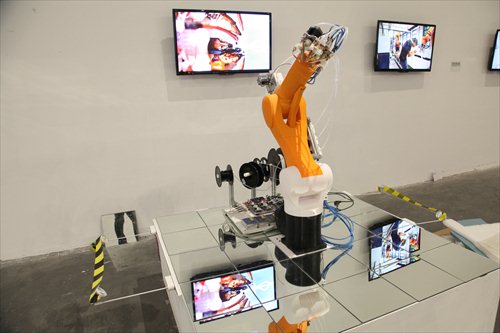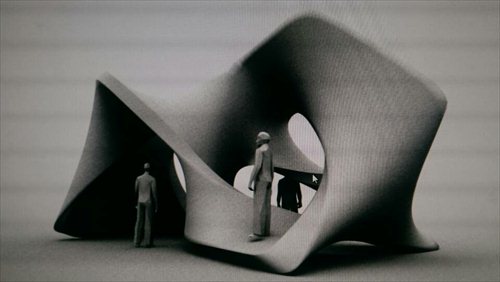Exhibition looks at role of robots in architecture
About 100 years ago, French artist Villemard depicted his vision of the year 2000 on a series of postcards named "Utopie." Among his audacious imaginings are whale-propelled submarines and firemen with artificial wings. While many of his predictions seem outlandish today, one that is bearing out is the important role of robots in creating architecture.
This is the central theme of the Robotic Future exhibition at Minsheng Art Museum, which is part of the ongoing 10th Shanghai Biennale. Architects from around the world have unveiled their latest works that demonstrate how they are using robots to incorporate elements into their structures that would not be possible in any other way.

The Robotic Future exhibition at Minsheng Art Museum explores the role robots can play in architecture. Photos: Courtesy of the museum
Futuristic pavilion
Architects from the Institute for Computational Design (ICD) and the Institute of Building Structures and Structural Design (ITKE) of the University of Stuttgart in Germany have created a futuristic pavilion that occupies an area of 50 square meters and measures 122 cubic meters in volume.
The pavilion is made up of 36 fabricated double-layered frames of glass and carbon fiber-reinforced polymers. The frames were made by a pair of robots. Each frame features a distinctive geometrical shape, and mimics the natural lightweight structure and shape of a beetle's shell.
The biggest frame measures 2.6 meters in diameter but weighs only 24.1 kilograms.

The Robotic Future exhibition at Minsheng Art Museum explores the role robots can play in architecture. Photos: Courtesy of the museum
The pavilion creates a novel space with a meandering path through it. Due to its open structure, the inner space enjoys light as bright as if it were outside. The space can also be easily modified by removing or adding frames.
Australian firm Studio Roland Snooks's eye-catching Composite Wing shows how the patterns on the surface of a building can not only be visually arresting but also reinforce the strength of the structure.
This is done in Composite Wing with two wing-like fiberglass installations. Its main vein-like foam patterns are complemented by smaller silicon patterns made by robots.
Industry 4.0
"What we see at the exhibition is a glimpse of the Industry 4.0 era, which features the intelligent factory that promotes computerization in manufacturing," said Yuan Feng, academic director of the exhibition. Yuan is also an associate professor of College of Architecture and Urban Planning at Tongji University.
"As for the architectural industry, changes brought by Industry 4.0 include buildings that are more efficient in using resources, more friendly in catering to the demands of people, and more adaptable to the surrounding environment."
Yuan's Topological Surface is a giant glass-reinforced plastic installation that is a single surface twisted into an irregularly shaped structure. Robots were programmed to create the complicated shape. Through Topological Surface, people will see the possibility of spatial creation. Meanwhile, ICD-ITKE is also showcasing videos of their other robotic explorations in architecture, with buildings that react to their environment, for example, by automatically opening and closing its skin in response to humidity.
Yuan told the Global Times that a number of leading universities are researching Industry 4.0 architecture, including University College London in the UK, Royal Melbourne Institute of Technology in Australia, Swiss Federal Institute of Technology in Switzerland, Harvard and MIT in the US, and Tongji University and Tsinghua University in China.

The Robotic Future exhibition at Minsheng Art Museum explores the role robots can play in architecture. Photos: Courtesy of the museum
Yuan added that the use of robots in architecture is becoming more common, such as in the newly built Shanghai Tower, for which computer simulation and robotic fabrication were used so it can counter the wind load; and the Phoenix International Media Center in Beijing, designed by Shao Weiping from the Beijing Institute of Architectural Design, in which computer modeling was used to create its flowing silhouette and elegant shape. Much new architecture has a novel appearance, which prompted Chinese President Xi Jinping to call for "no more weird architecture" in China. Yuan said architects should strike a balance when designing a building.
"If they are merely chasing some grotesque shape, it's really bad," he said. "But if they take into consideration scientific and technological concerns that can benefit people, it should be encouraged."
Date: Until February 28, 10 am to 6 pm (closed Mondays)
Venue: Minsheng Art Museum
民生现代美术馆
Address: Bldg F, Red Town, 570 Huaihai Road West
淮海西路570号红坊F座
Admission: 20 yuan ($3.18)
Call 6282-9287 for details